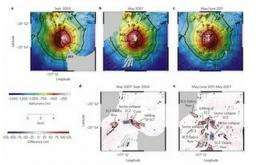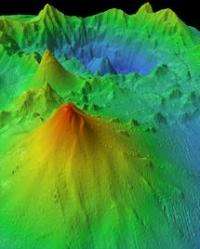May 14, 2012 report
Team observes rapid change in underwater volcano Monowai

(Phys.org) -- A research team out to perform routine mapping of the seafloor some 400 kilometers southwest of Tonga, found that one volcano, named Monowai, changed dramatically over just a two week time span. In an apparent underwater eruption, the volcano collapsed in one part and added almost 80 meters of height in another. The team has described their findings in a paper published in the journal Nature Geoscience.
Initially, the team had set out to do some simple mapping, but at one point were interrupted by yellow-green water that the team described as smelling like rotten eggs. They left the area, but then returned just two weeks later after seismic detectors went off on the Cook Islands, indicating that something big was occurring with Monowai. To their surprise, they found that some parts of the volcano had collapsed by as much as almost nineteen meters, while some had grown by as much as eighty.
Monowai is just one of the 32,000 mountains that lie under the world’s oceans, many of which are believed to be volcanic. Most oceanographers believe that far more volcanoes exist under the sea than on land; unfortunately, very little is known about them due to the difficulty in getting close enough to study them. Monowai, to the east of Australia, and north of New Zealand was first discovered by aircraft flying over the area during World War II, so close was its peak at the time to the surface. Subsequent visits to the site between 1978 and 2000 showed that the summit repeatedly rose and sank, prompting researchers to describe the mountain as pulsating, though it’s not yet certain if the changes are regular enough to warrant such a label.

The team believes that the smell they observed on their first trip to the site was likely due to hydrothermal venting of gases, which they suggest could have weakened the walls of part of the volcano, resulting in the collapse they observed when they came back later. In this case, the result was not a tsunami, but the team notes that it very easily could have been. Underwater landslides very often do result in destructive waves causing havoc many miles away. The suggest also that the added height was likely due to magma spewing forth from the volcano and then hardening in the water.
The team believes the increase in height they have observed on Monowai is larger than any ever seen on land save for Mount St. Helens and Vesuvius.
More information: Rapid rates of growth and collapse of Monowai submarine volcano in the Kermadec Arc, Nature Geoscience (2012) doi:10.1038/ngeo1473
Abstract
Most of Earth’s volcanoes are under water. As a result of their relative inaccessibility, little is known of the structure and evolution of submarine volcanoes. Advances in navigation and sonar imaging techniques have made it possible to map submarine volcanoes in detail, and repeat surveys allow the identification of regions where the depth of the sea floor is actively changing. Here we report the results of a bathymetric survey of Monowai submarine volcano in the Tonga–Kermadec Arc, which we mapped twice within 14 days. We found marked differences in bathymetry between the two surveys, including an increase in seafloor depth up to 18.8 m and a decrease in depth up to 71.9 m. We attribute the depth increase to collapse of the volcano summit region and the decrease to growth of new lava cones and debris flows. Hydroacoustic T-wave data reveal a 5-day-long swarm of seismic events with unusually high amplitude between the surveys, which directly link the depth changes to explosive activity at the volcano. The collapse and growth rates implied by our data are extremely high, compared with measured long-term growth rates of the volcano, demonstrating the pulsating nature of submarine volcanism and highlighting the dynamic nature of the sea floor.
Journal information: Nature Geoscience
© 2012 Phys.Org

















